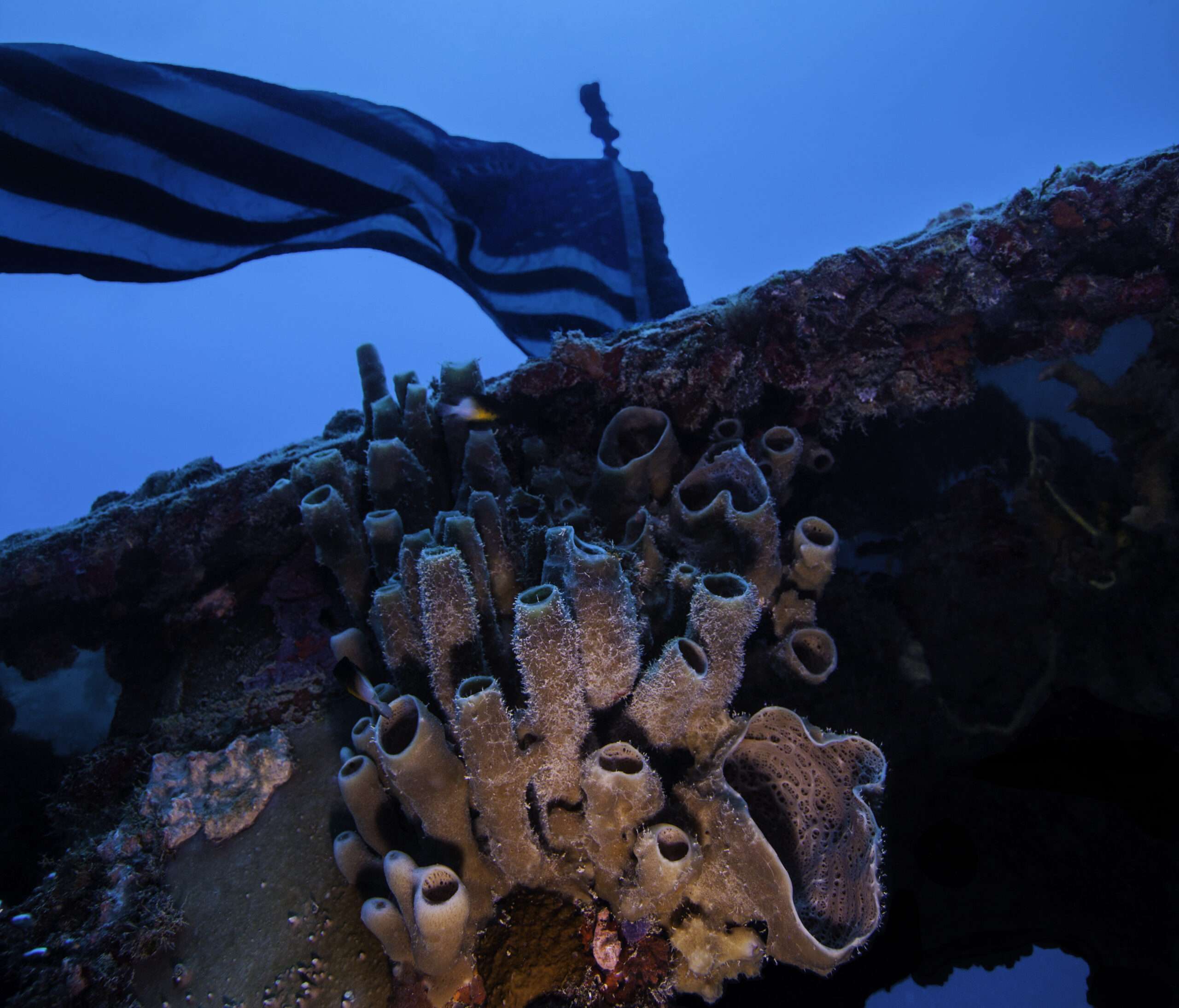There are hundreds of wreck dive sites scattered around the world. Each wreck has its unique history and features. Divers travel great lengths to get more wreck dives under their belt as these areas are often hubs for large schools of marine life. Many sink purposely to create artificial reef systems thereby increasing fish populations and bringing together scuba divers of all levels.
One of the most fascinating features that lure many divers out into the ocean is the history behind these wrecks. Learning about a ship when it was in its prime and then diving deep underwater to explore its final resting place is an incredible and contrasting experience. The longer a wreck is underwater, the more life it attracts.
Many shipwrecks are shallow enough for beginner scuba divers, but some may be much deeper, requiring a special certification. Not all wreck sites require an actual wreck diving certification and if the shipwreck rests in shallow waters, is easy to swim around, or has large swim-throughs, an open water diver certification will suffice. Deeper wrecks with multiple penetration areas will require an advanced open water certification or wreck diver certification at a minimum. Other sites require more advanced certifications like Nitrox, side mount, or other technical diving certifications.
BEST WRECK DIVES ON THE PLANET
BEST WRECK DIVES ON THE PLANET
USS Spiegel Grove
LOCATION
Key Largo, Florida
SIZE OF WRECK
510 feet
DIVING DEPTH
45-130 feet
QUALIFICATIONS TO DIVE
Advanced Open Water, Wreck, Deep
COMMONLY FOUND
Grouper, Parrotfish, Barracuda, Horse-eye jacks
PENETRABLE
Yes
Wreck diving in Florida is a must. The USS Spiegel Grove wreck dive is located just off the coast of Key Largo, Florida, and is one of the best wreck dives in the world. Turned upright by Hurricane Dennis in 2005, this 520-foot long U.S. Navy ship is a shipwreck divers dream. Sunk initially in 2002 to create an artificial reef system, the USS Spiegel Grove is a hub for marine life like giant grouper, barracuda, and horse-eye jacks.
Before sinking, from 1956 to 1989 the USS Spiegel grove spent its life helping enforce America’s Cold War containment strategy. This meant it would aid troops in taking equipment to friendly governments. The ship got its name from the 19th President of the United States, Rutherford B. Hayes’ estate in Ohio.
This “cliff-like” wreck dive is recommended for advanced open water divers or divers with an overhead diving certification, like PADI wreck diver. While scuba diving the Spiegel Grove divers will find many areas of the ship that are penetrable, but not deeper than 90 feet. Divers may not go below the main deck for safety reasons.
The USS Spiegel Grove is larger than any reef in the Florida Keys and is just six miles off Florida’s coast. Since sinking, it has become the backbone of the underwater ecosystem in the area. Many local dive shops use the massive wreck for morning two-tank dive trips, with the first dive being a shorter deep dive.
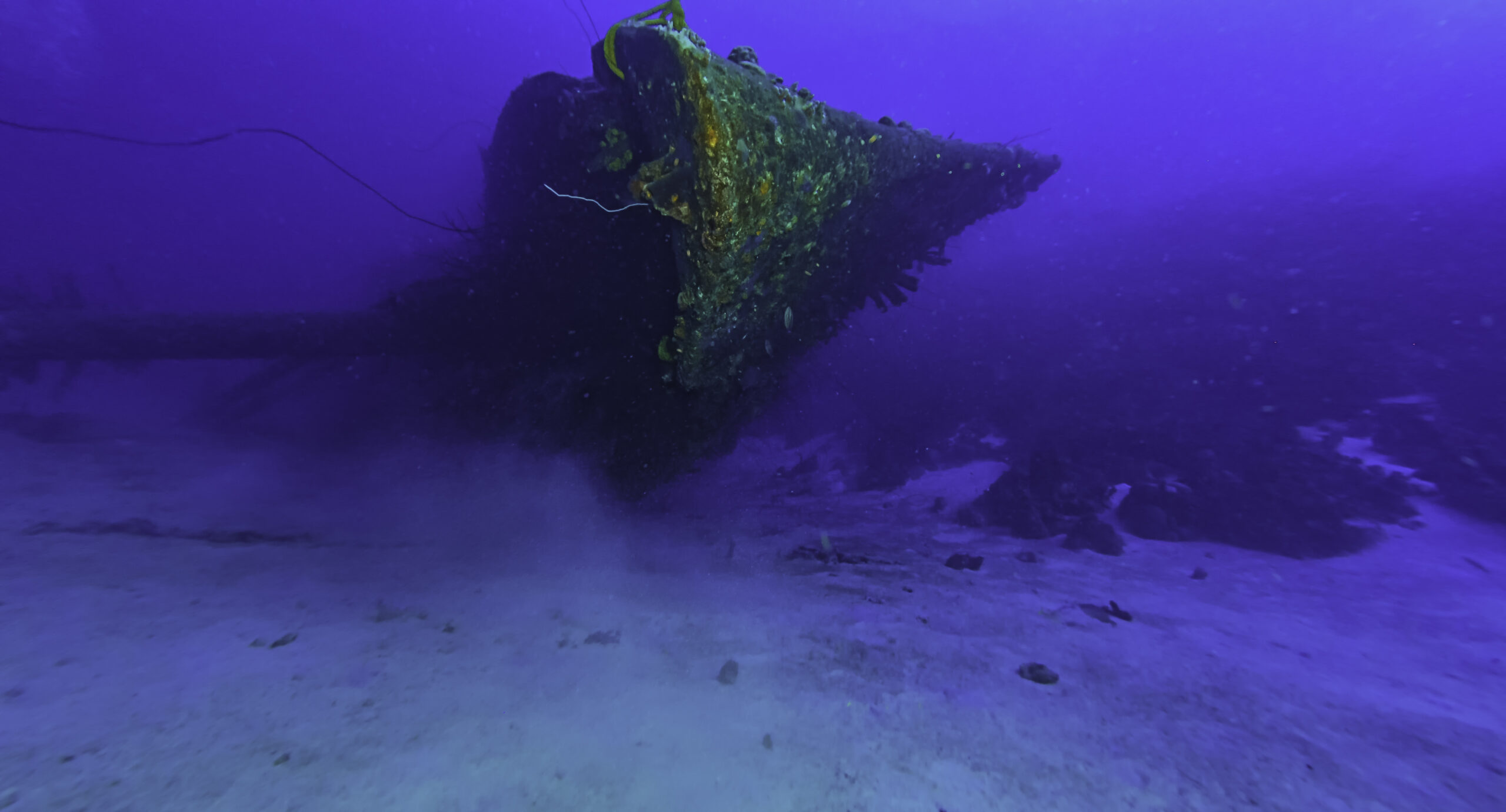
HMCS Yukon
LOCATION
San Diego, California
SIZE OF WRECK
336 feet
DIVING DEPTH
60-100 feet
QUALIFICATIONS TO DIVE
Advanced Open Water, Dry Suit, Wreck, Deep
COMMONLY FOUND
Anemones, Jellyfish, Sardines, Sheepshead, Surfperch
PENETRABLE
Yes
Located off Mission Bay in San Diego’s “Wreck Alley,” the HCMS Yukon dive is one of the newest wreck dives in the world. This 336-foot long Canadian Destroyer sits in 100 feet of water and is a hotspot for marine life like surfperch, sheepshead fish, and schools of sardines.
Due to its depth, an advanced open water certification is required. The water temperatures off the coast of California are quite cold, so most divers prefer a thick wetsuit, a hood, and gloves. A dry suit is also a preference to make this dive more comfortable. Despite the cold water temperatures, Wreck Alley is a popular destination for divers around the world.
The currents in the Pacific Ocean are strong, so penetrating the HCMS Yukon must be done carefully to prevent being pushed into sharp edges of the wreck. This massive ship has six decks and over 100 compartments. There are plenty of areas for divers to explore over multiple days of diving. Many dive shops provide diagrams of the inside of the Yukon, to prevent disorientation.
The HCMS Yukon rests comfortably on its port side but sunk before planned. The night before the scheduled sinking and spectator ceremony, large swells rolled the ship, and it began to take on water, sinking it in its current resting place.
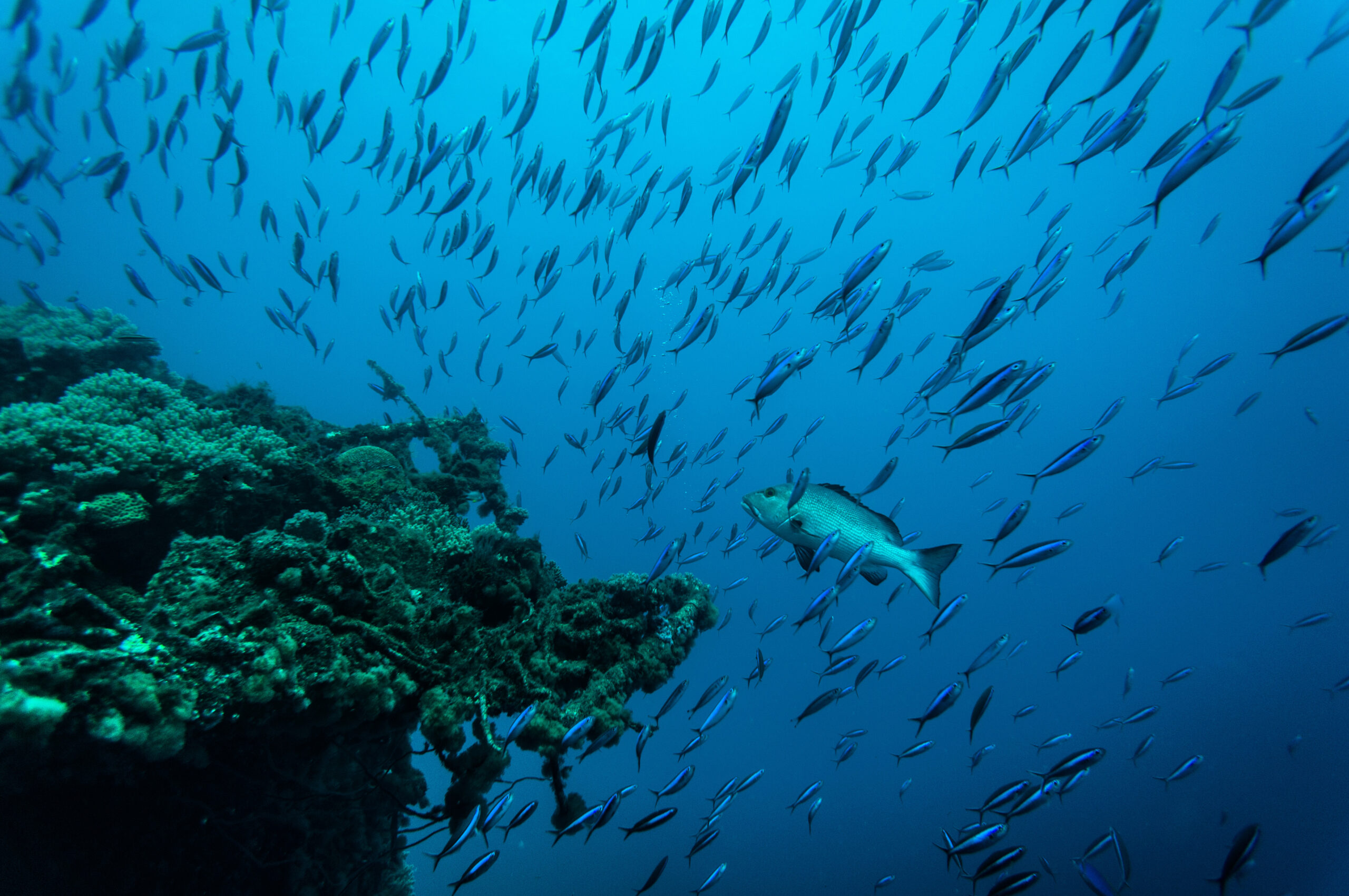
SS Sapona
LOCATION
Bimini, Bahamas
SIZE OF WRECK
282 feet
DIVING DEPTH
15-60 feet
QUALIFICATIONS TO DIVE
Open Water
COMMONLY FOUND
Lobster, Sergeant Majors, Small Reef Fish
PENETRABLE
Yes
Sitting in the shallow waters of the coast of South Bimini in the Bahamas, the SS Sapona is a popular location for snorkelers and scuba divers with a love of marine life and shipwrecks. The SS Sapona is a concrete ship initially commissioned by the United States President, Woodrow Wilson. In its prime, this ship served as a troop transport vessel during World War I and is said to be designed by Henry Ford and thereafter built in North Carolina by the Liberty Ship Building Company.
The construction of the SS Sapona ended just after the war, it was then sold to a developer in Miami Beach and used as a casino. In 1924 it was sold to liquor distributor Bruce Bethel “Bimini’s Rum King” in the Bahamas and used as a floating storage warehouse and distribution center during prohibition.
Two years later, the ship ran aground and was severely damaged becoming a bombing target during World War II. Years of bombing and weathering have caused the hull to become worn, but it has become home to many types of fish and other marine life. The SS Sapona sits in white sand and with most of its structure sitting out of the water, it provides a perfect photo opportunity for lovers of the sea.
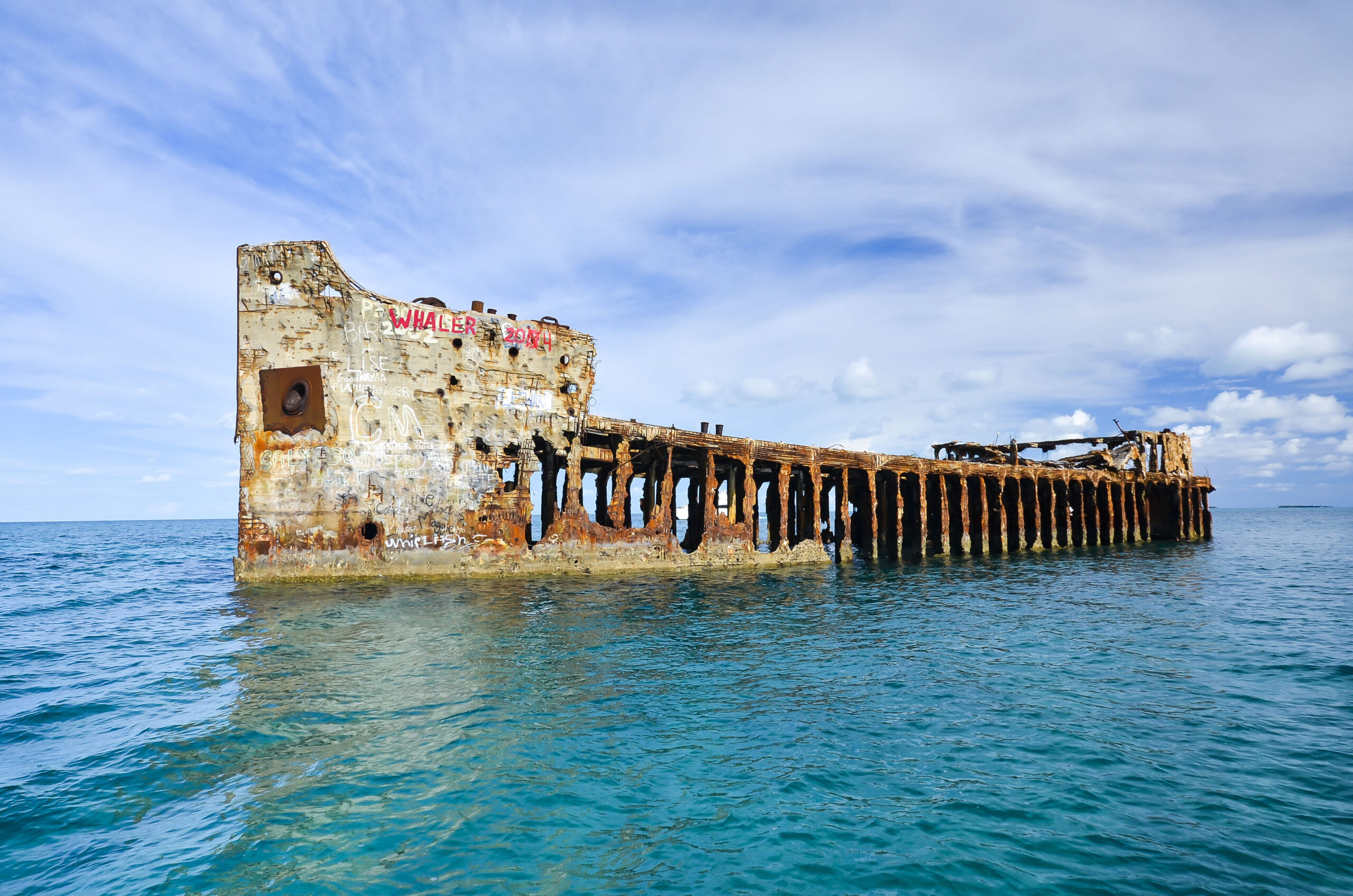
USS Kittiwake
LOCATION
Seven Mile Beach, Grand Cayman
SIZE OF WRECK
251 feet
DIVING DEPTH
15-60 feet
QUALIFICATIONS TO DIVE
Open Water
COMMONLY FOUND
Stingrays, Garden eels, Sea turtles, Grouper, Barracuda
PENETRABLE
Yes
Located in shallow water just off the coast of Seven Mile Beach in Grand Cayman, The USS Kittiwake dive is one of the world’s top shipwreck dives. The USS Kittiwake is 251 feet in length, and the maximum depth is 60 feet making it a perfect dive for beginners. Garden eels hunker in the sand around the wreck, and many divers encounter stingrays, sea turtles, and groupers on their dives. The shallow depth and variety of marine life also make it excellent for snorkelers to explore.
The USS Kittiwake was a submarine rescue ship during World War II and, after 49 years of service, was decommissioned in September of 1994. The Grand Caymans government worked in partnership with the United States Maritime Administration to clean and prepare the ship to be sunk and used as an artificial reef. The cleaning and preparation included cutting large holes in the vessel’s hull to make it easier to penetrate and allow currents to pass through once at rest at the bottom of the sea.
Sunk only 800 yards off the sand of Seven Mile Beach, the USS Kittiwake is easy to get to (yet another reason for its popularity). The captain’s wheel is still intact, and an excellent backdrop for divers to take photos. The abundance of marine life coupled with 100-foot visibility means the USS Kittiwake is a diver’s dream. This is a protected marine park and so diving there will cost a small fee.
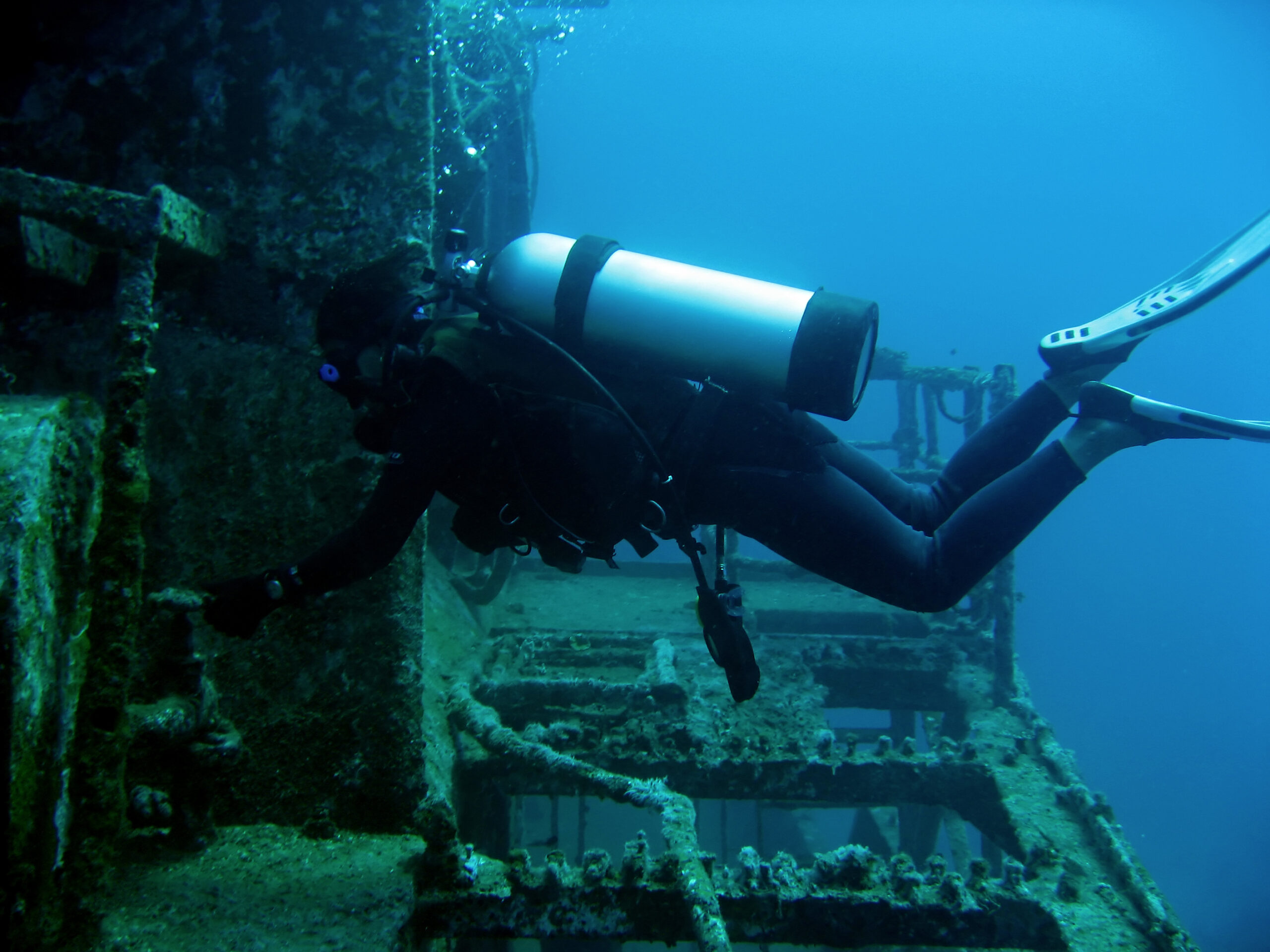
USS Saratoga
LOCATION
Bikini Atoll, Marshall Islands
SIZE OF WRECK
880 feet
DIVING DEPTH
40-190 feet
QUALIFICATIONS TO DIVE
Advanced Open Water, Deep, Tech
COMMONLY FOUND
Sharks, Devil whips, Sponges, large schools of fish
PENETRABLE
Limited
The USS Saratoga cv-3 wreck seems a world away. Sitting in 190 feet of water near Bikini Atoll in the Marshall Islands. The USS Saratoga, a Naval aircraft carrier, is the largest diveable shipwreck in the world. At 880 feet more than the Titanic, the USS Saratoga is known for shark sightings and is home to large schools of fish. It is one of the many shipwreck sites in the Pacific Ocean sunk during World War II.
After its prime, the USS Saratoga was a victim of H-bomb tests in Bikini Atoll during the late 1940s. Divers have not been able to explore this historic site until recently. Due to this dive’s difficulty, operators recommend having at least an advanced open water certification, if not a tech diver certification or two. Wreck diver certification is also a plus.
The hull of this aircraft carrier is full of devil whips and colorful sponges which are great for photo opportunities. Divers sometimes spend up to seven days exploring this sunken aircraft carrier’s many rooms, levels, and shafts. Divers can also explore multiple hangars with military equipment, planes, guns, and torpedoes.
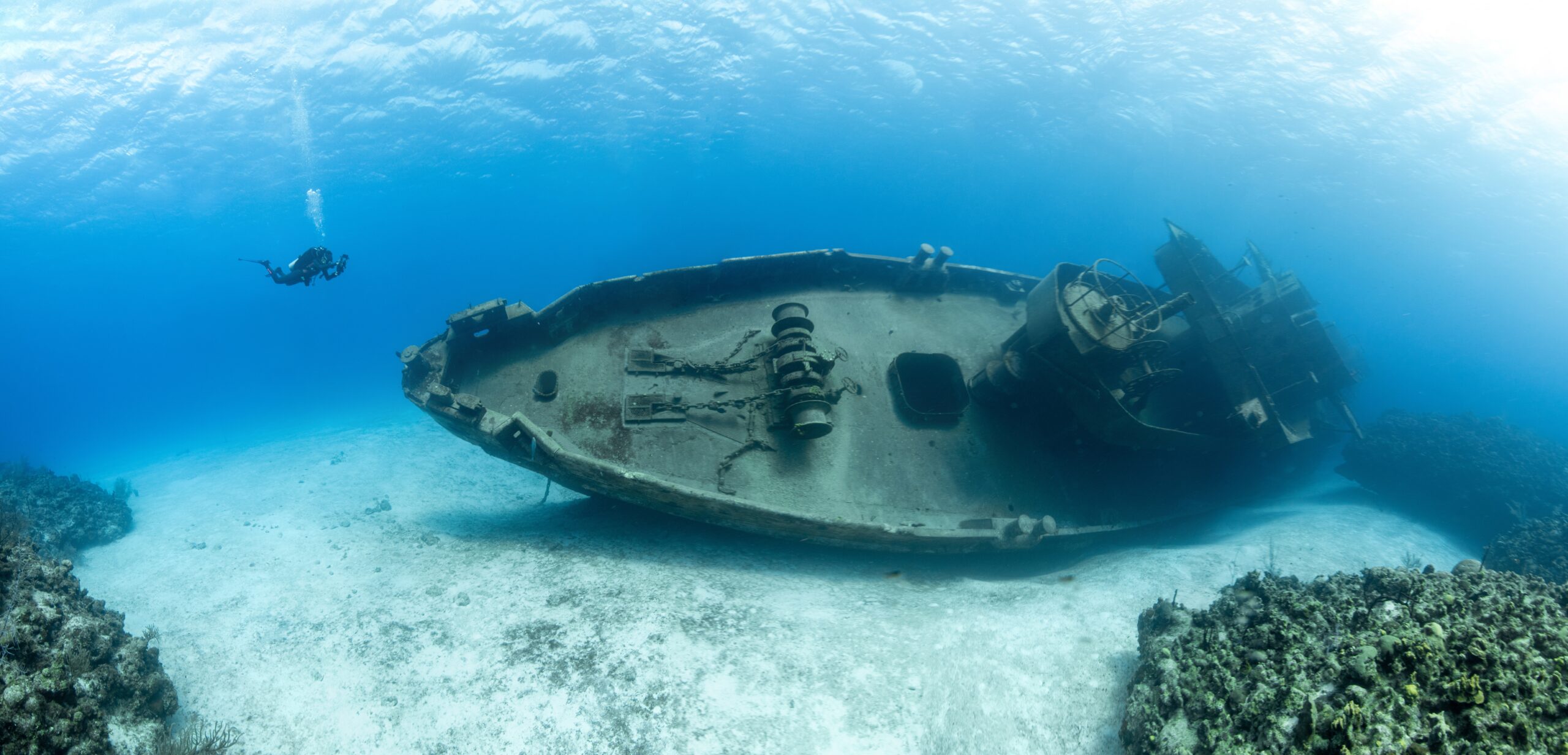

SS Stavronikita
LOCATION
Fitts Village, Barbados
SIZE OF WRECK
365 feet
DIVING DEPTH
60-135 feet
QUALIFICATIONS TO DIVE
Advanced, Wreck, Deep
COMMONLY FOUND
Sea Turtles, Black coral, Sergeant majors, Amberjacks
PENETRABLE
Yes
A large shipwreck with its bow facing the platinum west coast of Barbados, the SS Stavronikita is considered one of the best shipwreck dives in Barbados or even the Caribbean. Once used as a freighter, this Greek vessel was carrying a load of cement when it caught on fire off the island’s coast. The ship drifted for days and lost six crew members before being rescued and towed into the port in Barbados.
After sitting in the port, the government of Barbados purchased the ship and prepared it to be safely sunk to create an artificial reef. Initially, the foremast of the vessel was meant to sit above water after being sunk, but when the charges blew, and the ship began to sink, it slid backward on a sandbank where it currently sits in 135 feet at the stern.
The SS Stavronikita is now a perfect deep dive for advanced open water and wreck divers. It is home to sea turtles, black corals, and schools of sergeant majors. It will take more than one dive to see all there is to see at this wreck site, but the divers who love to go deep will be amazed. Some of the most spectacular sites on this ship are the size of the larger propeller, which is sitting intact at 135 feet, and the wheelhouse, which makes for an excellent swim-through. The mid-ship has started to collapse in recent years, making it unsafe to penetrate, but the many cargo holds are open for exploration.
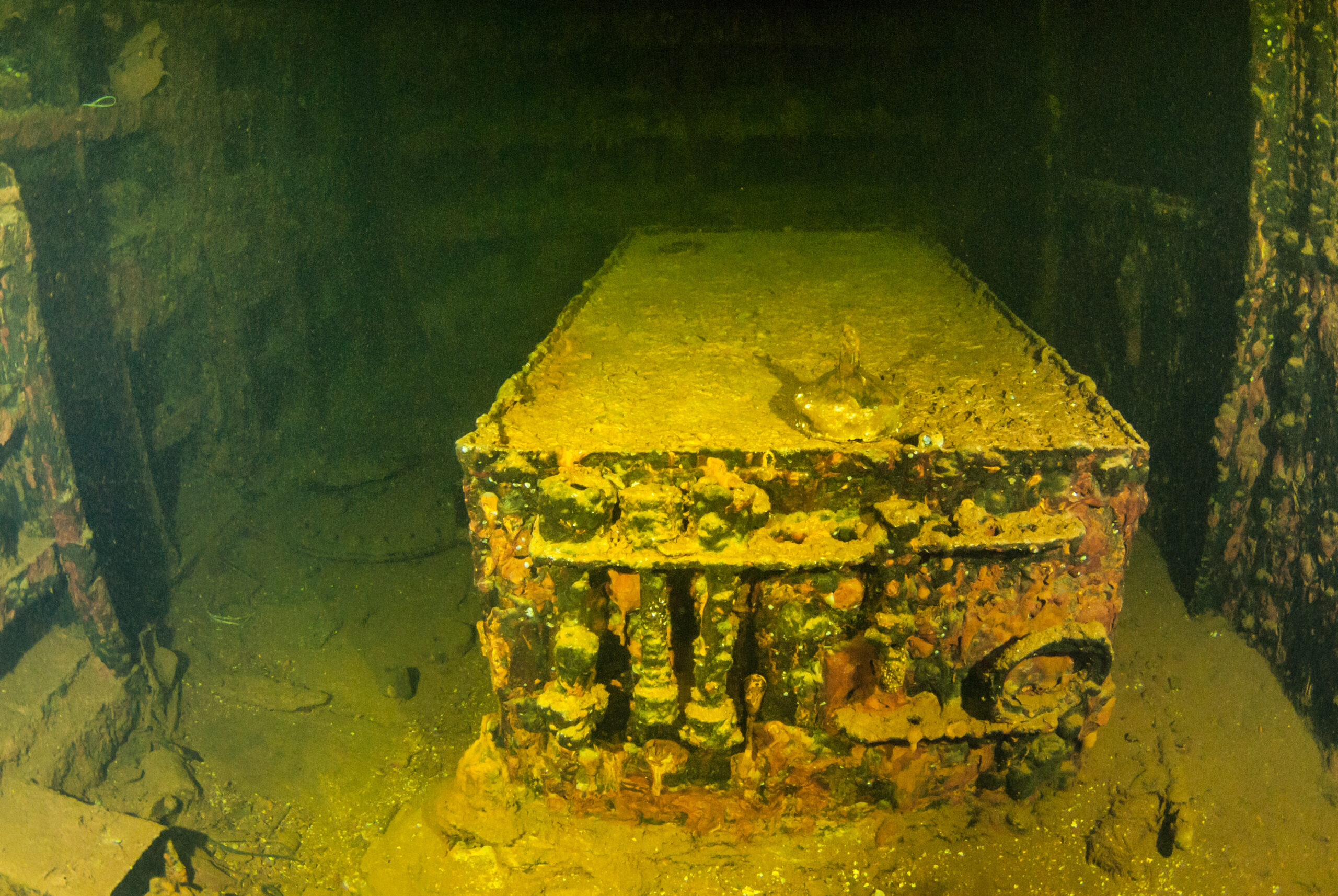

Fujikawa Maru
LOCATION
Truk (Chuuk) Lagoon, Micronesia
SIZE OF WRECK
450 feet
DIVING DEPTH
30-115 feet
QUALIFICATIONS TO DIVE
Open Water, Advanced Open Water, Wreck, Tech
COMMONLY FOUND
Artifacts, Soft coral, Damselfish
PENETRABLE
Yes
A top wreck dive in Micronesia and possibly one of the best in the world, the Fujikawa Maru was a cargo ship converted by the Japanese Imperial Army into an armed aircraft transport ferry. This large 450-foot ship went down during an attack by American forces in Truk Lagoon.
The Fujikawa Maru is an excellent wreck dive for beginner divers and advanced scuba divers alike as it sits between thirty to one hundred and fifteen feet. For more advanced divers, the engine room (part of which is collapsed) is penetrable by following a staircase. While exploring the wreck, divers can find historical artifacts, colorful hard and soft corals, and damselfish schools. In one of the forward cargo holds of the Fujikawa Maru, there are four disassembled Mitsubishi fighter aircrafts and a gun on the bow used in war times.
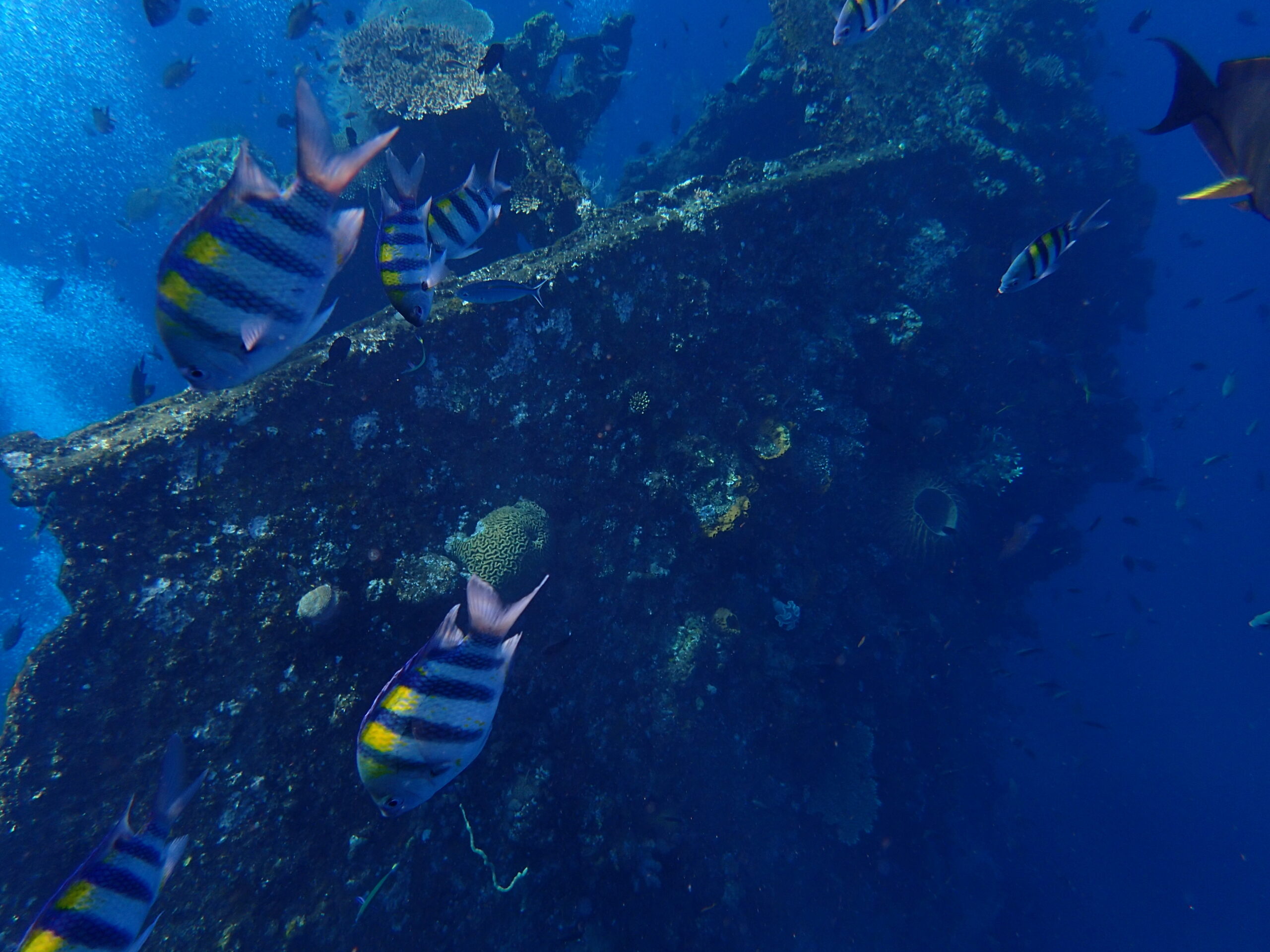

Hilma Hooker
LOCATION
Bonaire
SIZE OF WRECK
236 feet
DIVING DEPTH
25-100 feet
QUALIFICATIONS TO DIVE
Open Water, Advanced Open Water, Wreck
COMMONLY FOUND
Tarpon, Lobster, Barracuda, Snapper, Angelfish
PENETRABLE
Limited
The Hilma Hooker is a world-renowned shipwreck located off the coast of Bonaire that can be reached by shore entry or by boat. Once a cargo ship built in the Netherlands, this 236-foot ship was suspected for drug trafficking, searched, and found with 25,000 pounds of marijuana hidden in a false bulkhead.
Now home to giant tarpon, lobster, snapper, and angelfish the Hilma Hooker sank in September of 1984 after the bilge pumps failed, and it began to take on water. Divers should exercise caution when diving and penetrating this wreck as it was not cleaned before sinking. The Hilma Hooker is part of the Bonaire National Marine Park, and a fee is required to enter and dive the protected area.
The wreck rests on its starboard side in between two reefs, making it an excellent place for divers to explore the underwater world. This is one of the coolest shipwrecks in the Caribbean – open water divers can explore the shallow areas of the wreck and surrounding reefs, but a wreck diver or advanced diver certification is needed to go inside. In Bonaire, the visibility is usually one hundred feet plus, which is great for photo opportunities with this large sunken vessel.
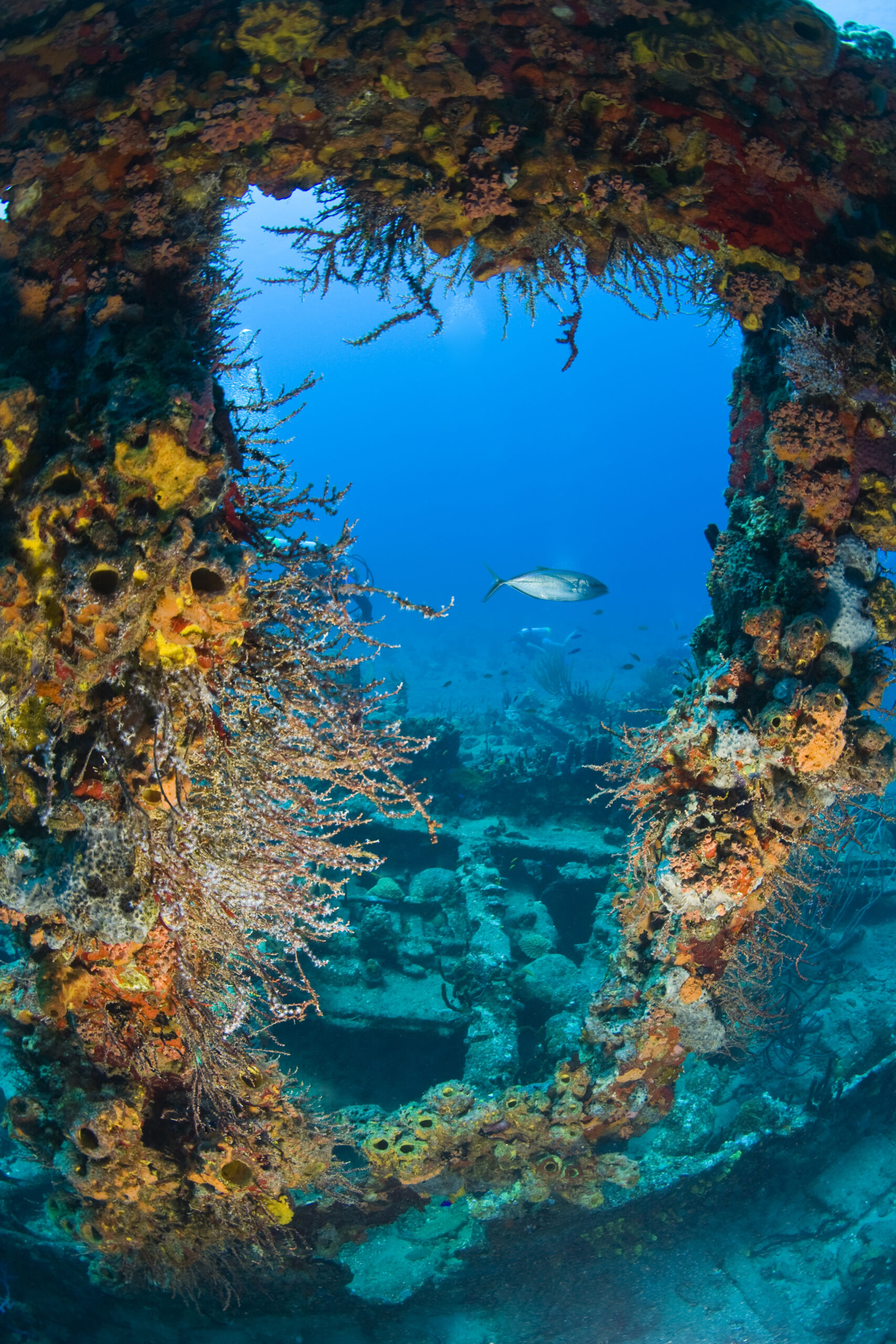

USAT Liberty
LOCATION
Bali, Indonesia
SIZE OF WRECK
394 feet
DIVING DEPTH
15-72 feet
QUALIFICATIONS TO DIVE
Open Water
COMMONLY FOUND
Parrotfish, Potato cod, Batfish, Yellow mask surgeons
PENETRABLE
Limited



A beginner diver’s paradise, the USAT Liberty sits in shallow waters off Bali’s coast in Indonesia. The top of the wreck lies at just fifteen feet underwater and at seventy-two at its deepest section. Large numbers of parrotfish, potato cod, and yellow mask surgeons roam the wreckage and surrounding areas, and if you are lucky, you will find batfish roaming the wreck.
Once a cargo ship during World War II, the USAT Liberty is 394 feet long and is mostly intact due to a minimal current passing by. Divers enter over a rocky shore, so dive booties are recommended for this wreck site, as old coconut tree trunks guide divers to the wreck.
Because this is a large wreck that is easy to dive, many dive shops will explore the USAT Liberty daily, and divers usually enjoy visiting it more than once. When it comes to underwater wrecks and photography, this shipwreck has it all for divers who love the small things like nudibranchs.
RMS Rhone
LOCATION
Salt Island, British Virgin Islands (BVI)
SIZE OF WRECK
310 feet
DIVING DEPTH
30-80 feet
QUALIFICATIONS TO DIVE
Open Water, Advanced Open Water
COMMONLY FOUND
Seahorse, Sea turtles, Eels, Nudibranchs
PENETRABLE
Swim-throughs
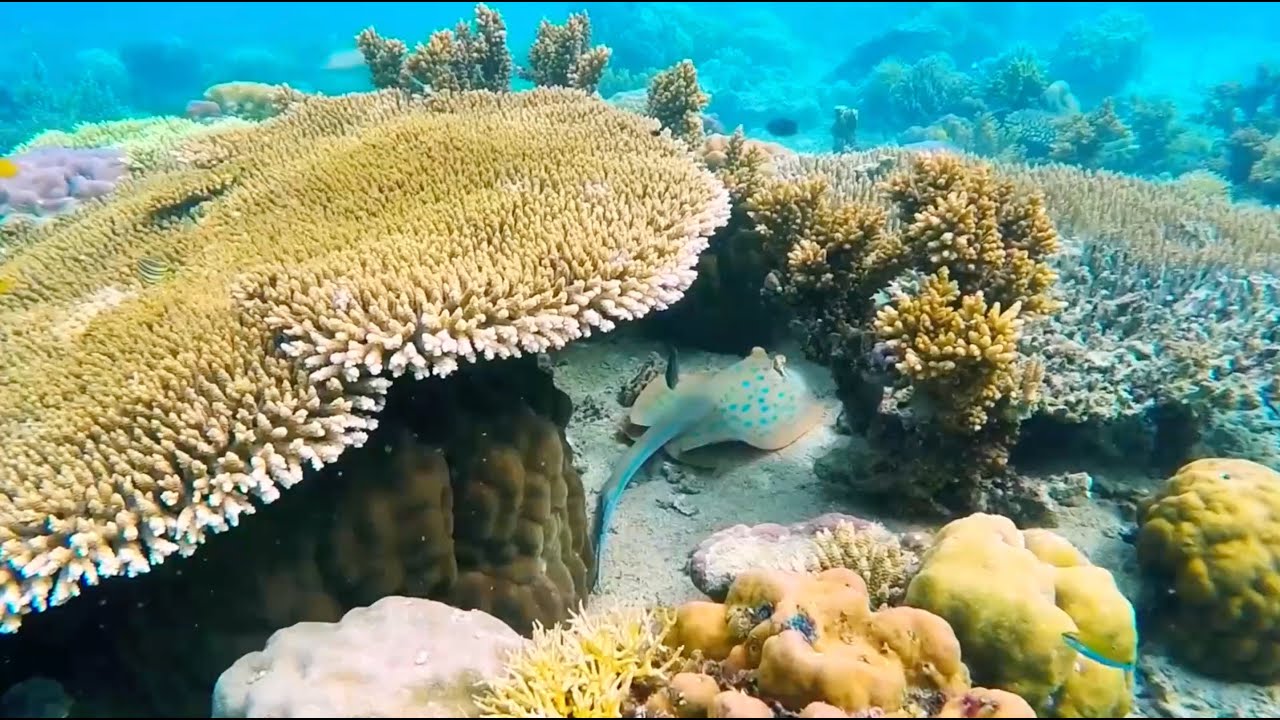

Built-in Cornwall, England, in 1865, the RMS Rhone is the premier dive site in the British Virgin Islands. Located just off the coast of Salt Island, this shipwreck was sunk in 1867 and holds many historical artifacts, making it a perfect dive for history lovers.
At the stern, divers can see the fifteen-foot propeller where the bow remains mostly intact. The RMS Rhone rests on its side and boasts many swim-throughs requiring only an open water certification. Lucky divers will meet green morays and at least one octopus on their dive, along with sea turtles and seahorses who live in the 310-foot long shipwreck. The RMS Rhone can be seen over two consecutive dives, one deep and one shallow to get its full effect. This is also a popular night dive site for divers who enjoy hopping into the sea after dark.
FINAL THOUGHTS
Best Wreck dives on the planet
These 10 shipwrecks are among the best shipwrecks around the world and are sure to excite any diver whether at an experienced or beginner level. Every year more lost shipwrecks are discovered, and new ships are sunk to create artificial reef ecosystems. The most exciting part about diving in at a wreck site is that you know you will see something unusual, whether it be marine life, ancient artifacts, or the beauty of a ship with a rich history.
Traveling the world for scuba diving shipwrecks can be exciting, so be sure to bring a camera to capture your adventures and keep the stories for future generations.
BEST WRECK DIVES ON THE PLANET
FAQs
What makes wreck diving so great?
Best wreck dives can be a bit scary at first but they are home to many unique sea creatures. Wrecks provide a safe place for marine life to hunker down and for divers to explore. One big selling point to wreck diving is the history behind each ship. Whether it be a concrete cargo vessel or a ship used in a past war, shipwrecks carry links to the past that are explorable before, during, and after diving in. Wreck divers also like the excitement of seeing what is around the corner and visualizing what the ship looked like in its prime.
Is Shipwreck diving safe?
Shipwreck diving is safe, but it is recommended to follow safety and certification guidelines before diving. Certain shipwrecks have swim-throughs that are great for new divers, but others may be deep or large enough that it is easy to get lost. Divers should always get a pre-dive briefing to orientate themselves before diving and plan the dive carefully for safety purposes. Anytime you dive into an overhead environment, there are risks, so taking a course that prepares you for these situations is essential.
Do I need a certification to wreck dive?
Not all wreck dives require a special certification. Small wrecks that are not penetrable are great for open water divers. Wrecks that are penetrable may require specialized training. Depending on the depth, condition of the shipwreck as well as the currents, some dive operators may require particular qualifications like advanced open water diving, wreck diving, and deep diving. For a more technical wreck site, a tech diver specialty or nitrox course is recommended. Many dive shops offer courses that allow divers to explore wrecks and attain these certifications at the same time, win-win.
Is the PADI Wreck Diver Course worth it?
The PADI wreck diver course teaches divers how to dive in and around wrecks safely. In the PADI wreck diver course, divers learn about entry and exit points, navigation, running lines to help guide them, and how to prevent touching sharp objects on a wreck. These are essential items to know – especially if you are new to diving. It is easy to get disoriented underwater, and when you enter the structure of a wreck, the risks of this increase. Many dive shops and liveaboards require the PADI wreck diver course depending on the location and the depth of the wreck, so it is worth it to get certified if you like wreck diving and want to be safe.
What happened to the USS Spiegel Grove (LSD-32)?
After spending twelve years as a United States naval ship in the James River in Virginia the USS Spiegel Grove was towed to Key Largo, where it was to spend 11 months being cleaned and prepared to be sunk to create an artificial reef in the Florida Keys. In May of 2002, just hours before the planned sinking, the ship was rolled over and sank unexpectedly. In June of 2002, the vessel’s scuttling was completed and laid to rest on its starboard side. However just three years later, Hurricane Dennis rolled the wreck upright to where it sits today.
What do USS and HMS stand for?
USS stands for United States Ship and means that the vessel is owned and operated by the United States Navy. These ships are or once were manned by officers and crew of the United States Navy. Similarly, in Naval terms, HMS stands for Her Majesties Ship. Her Majesties Ship is used for vessels in the United Kingdom.
Can you take artifacts from a shipwreck?
Shipwrecks have history, which means they may have items in or on them that would make a good souvenir, but it is not good to take anything from a wreck while diving. In some cases and some areas, this may even be illegal, so you should never tamper with artifacts on a shipwreck. Touching things in a shipwreck can also be dangerous. Coral and other marine organisms can sting or cut your skin, so it is best not to touch anything while scuba diving at a wreck dive site. Leaving historical artifacts or pieces of a ship in place also allows other divers who come later to have the same great experience when scuba diving shipwrecks.
REACH OUT
If you enjoyed our article but would prefer snorkeling on the east coast instead, fret not, we have put together some great content on the best snorkeling spots in Florida as well. We also have a review that only covers Florida Keys snorkeling locations.
As always, we create our content with you – our fellow divers – in mind. So, how’d we do? Was this informative? Do you think our rankings are out of whack? Or perhaps you just have a few golden nugget tips you’d like to share with our happy ocean-loving community? We’d love to hear from you below.
Thanks for reading and we hope your next adventure is a great one – Keep Diving Blue!


